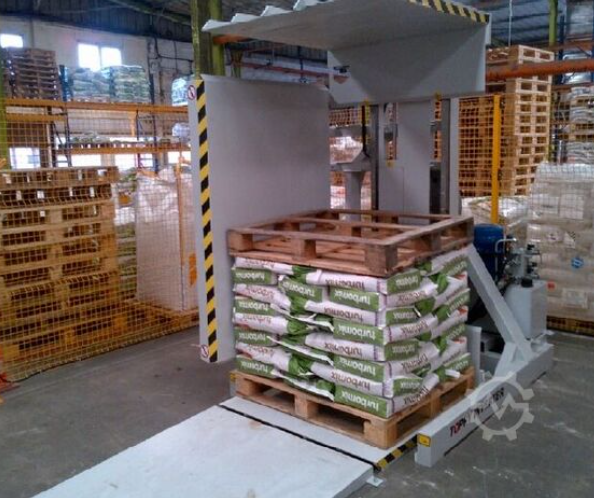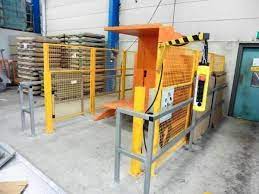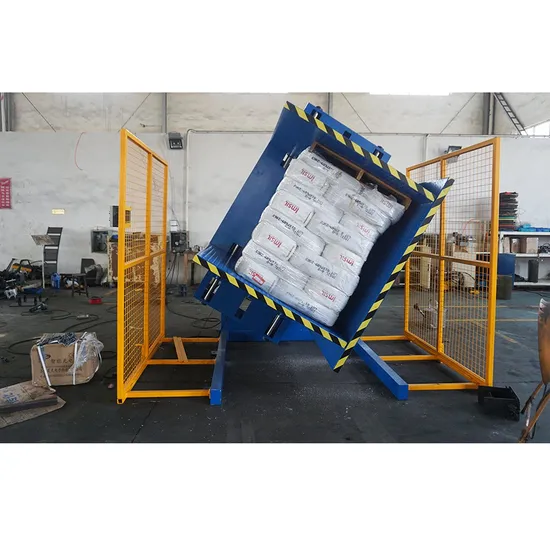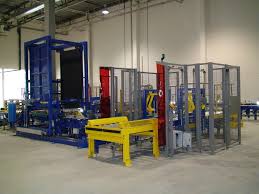Pallet Changing Machine: How Can Dairy Plants Swap Cream Pallets Without Contamination?
In my years as an engineer and later as a factory owner, I’ve seen one problem repeat across countless industries: the risky, final step of moving finished goods. In a dairy plant, this challenge is critical. You have pallets stacked high with valuable cream, ready for shipment. But they are often on in-house, reusable wooden pallets. To ship them, you need to transfer them to clean, one-way pallets. Doing this by hand is slow, laborious, and opens the door to a disaster. A single splinter from a wooden pallet or a moment of carelessness can contaminate an entire batch, leading to costly recalls and destroying customer trust. It's a constant source of anxiety for any plant manager who values quality and safety above all else.
A dairy plant can swap cream pallets without contamination by using a specialized pallet changing machine, often called a pallet inverter. This equipment automates the transfer process entirely. It works by securely clamping the palletized load, often with adjustable pressure, and then rotating it 180 degrees. This allows the original, potentially contaminated wooden pallet to be easily removed from the top. A new, hygienic plastic or shipping pallet is then placed on the load, and the machine rotates everything back. This hands-free method prevents the product from ever touching the floor, minimizes human contact, and effectively eliminates the risk of physical contaminants entering the product.

This automated solution is more than just a piece of machinery; it's a guarantee. It transforms a high-risk manual task into a controlled, repeatable, and safe process. It’s about building a system that protects your product, your brand, and your bottom line. Let's dig deeper into the specific risks and how this technology provides a definitive solution.
What Are the Primary Contamination Risks When Swapping Cream Pallets?
You work tirelessly to maintain a sterile environment inside your dairy processing facility. Every surface is stainless steel, every process is controlled. But then the product reaches the final step: pallet swapping. Suddenly, you introduce a major variable—the pallet. You might think a pallet is just a pallet, but in a food-grade environment, it's a potential Trojan horse for contaminants. Relying on manual labor to swap these pallets magnifies the risk. Every touch, every movement is a chance for something to go wrong, turning a simple logistics task into a high-stakes gamble with your product's integrity.
The primary contamination risks when swapping cream pallets fall into three categories. First are physical contaminants like wood splinters, nails, dust, and debris from old or damaged wooden pallets. Second are biological contaminants, such as bacteria and mold, which thrive in the porous, moisture-absorbing structure of wood. Third are chemical contaminants from substances the pallet may have been exposed to previously. Manual handling further increases the risk of cross-contamination from the floor, workers' hands, or the general warehouse environment.

The Obvious Danger: Physical Contaminants
Physical contaminants are often the most visible and easily understood risk. Wooden pallets, especially those that are reused multiple times, inevitably degrade. They splinter, nails can work their way loose, and they accumulate dust and dirt that can be dislodged during handling. When workers manually unstack and restack tubs or boxes of cream, it is very easy for a small wood chip or piece of debris to fall into a container or get stuck in the packaging, only to be discovered by the end consumer. This not only poses a safety hazard but also guarantees a customer complaint and damages your brand's reputation for quality.
| Contaminant Type | Source Example | Potential Impact on Cream |
|---|---|---|
| Wood Splinters | Degraded wooden pallets | Physical hazard if ingested, customer complaints |
| Loose Nails/Staples | Broken pallets | Punctured packaging, product leakage, safety hazard |
| Dust and Debris | Pallet surface, warehouse floor | Compromised product purity, "dirty" appearance |
| Plastic Shards | Damaged plastic pallets | Physical hazard, similar to wood splinters |
The Invisible Threat: Biological Contaminants
While you can see a wood splinter, you can't see bacteria. This is what makes biological contaminants so dangerous. Wood is a porous material. It absorbs moisture from spills, condensation, and even the air in humid environments. This moisture turns the wood into an ideal breeding ground for bacteria like Listeria, E. coli, and various types of mold. Even if a wooden pallet looks clean, it can be teeming with microorganisms. Standard cleaning procedures are often insufficient to sanitize wood fully. When a pallet of cream sits on such a surface, there is a constant risk of these microbes migrating to the packaging and, eventually, to the product itself, especially if there is any minor damage to a container. This risk is unacceptable in the dairy industry, where product safety is paramount.
The Unseen Transfer: Cross-Contamination
The very act of manually handling the product introduces another layer of risk. When employees have to lift and move individual cases or tubs, they create multiple touchpoints where contamination can occur. Their gloves may have touched other surfaces, or the product might be temporarily placed on the floor. The simple act of moving the pallet with a forklift can kick up dust and debris from the floor, which can then settle on the product. Every step in a manual process is an opportunity for something from the outside environment to compromise the sterile condition you worked so hard to create. An automated system like a pallet changer contains the entire process, effectively building a wall between your product and these environmental risks.
How Does a Pallet Changer Mechanically Prevent Cross-Contamination?
So, you understand the risks. But how exactly does a large piece of equipment solve a problem that seems to be about tiny particles and microbes? It's natural to be skeptical. I’ve seen many factory managers worry that adding another machine just adds complexity. You wonder if it will be reliable, if it will be truly clean, and if it's worth the investment. The answer lies in its core mechanical function, which is elegantly simple. It's designed to do one job perfectly: transfer a load from one pallet to another without the product ever being compromised. It isolates the goods from the outside world during the entire critical transfer.
A pallet changer prevents cross-contamination by using a secure clamping and rotation mechanism. It uses clean, non-porous pressure plates to hold the entire load together as a single, solid block. By clamping from the top and sides, it lifts the products, allowing the old pallet to be removed without any manual touching of the goods. The machine then presents the inverted load for a new, clean pallet. This process ensures the product never makes contact with the floor and is shielded from airborne dust, all within a fast, automated cycle.

The Clamp and Invert Method
The most common type of pallet changer is the pallet inverter. Its operation is straightforward and highly effective. Here’s how it works, step-by-step:
- A forklift places the entire palletized load (e.g., cream on a wooden pallet) into the machine.
- The machine’s side walls and top plate close in, applying gentle but firm and evenly distributed pressure. This stabilizes the entire load, treating dozens of individual boxes or tubs as one solid unit.
- The machine then rotates the entire clamped load a full 180 degrees. The original wooden pallet is now on top, and the bottom of the load is facing up.
- The machine’s original base plate moves away, allowing the wooden pallet to be easily lifted off by the forklift. It never has to be manually handled or broken down.
- A new, clean plastic or shipping pallet is placed on top of the inverted load.
- The machine rotates 180 degrees back to its original position. The load of cream is now sitting securely on the new, clean pallet, ready for shipment.
This entire process happens without a single human hand touching the product. The product is contained and protected at all times, eliminating the risks we discussed earlier.
Materials and Design Engineered for Hygiene
The mechanical action is only half of the solution. The machine itself must be designed for a hygienic environment. This is where, as an engineer, I focus on the details.
| Design Feature | Mechanical Purpose | How It Prevents Contamination |
|---|---|---|
| Stainless Steel Construction | Provides strength and corrosion resistance. | The surface is non-porous, preventing bacteria from finding a place to grow. It will not rust or shed particles. |
| Smooth Welds | Creates a seamless surface. | Eliminates tiny cracks and crevices where food particles and microbes could accumulate. |
| Open, Accessible Frame | Allows easy access to all parts. | Simplifies cleaning and inspection, ensuring no hidden areas of contamination can build up. |
| Adjustable Clamping Pressure | Protects the product being handled. | Prevents crushing or damaging the cream containers, which would cause spills and create a biological hazard. |
When I design equipment, whether for steel coils or food products, I think about how it will be used and maintained. A machine that is difficult to clean will not be cleaned properly. Therefore, a pallet changer built for the dairy industry is fundamentally different from a standard warehouse model. It’s built from the ground up with hygiene as its primary design principle.
Which Pallet Changer Features Are Critical for a Hygienic Dairy Environment?
You're convinced that a pallet changer is the right direction. But the market has many options. Choosing the wrong machine can be a frustrating and expensive mistake. You could end up with a piece of equipment that doesn't meet strict dairy industry regulations, is a nightmare to clean, or, even worse, damages your product. You're not just buying a machine; you are investing in a critical control point for your facility's hygiene. Getting the details right from the start is essential to ensure that investment pays off.
For a hygienic dairy environment, the most critical pallet changer features are stainless steel construction (specifically food-grade 304 or 316), a full wash-down capability with IP65-rated motors and electronics, and a design that features smooth, polished welds and no pockets or crevices where bacteria can hide. Additionally, programmable and adjustable clamping pressure is vital to handle delicate products like cream tubs without causing damage or spills.

Material Matters: Stainless Steel and Wash-down Design
In any food processing environment, the choice of material is non-negotiable.
- Stainless Steel Construction: The frame, clamping plates, and any surface that could potentially be in the product zone must be made of stainless steel. Grade 304 is the industry standard due to its excellent corrosion resistance and cleanability. For environments with harsher cleaning chemicals, grade 316 offers even greater resistance. This prevents rust and pitting, which can harbor bacteria and contaminate products.
- Wash-down Capability: A dairy plant is regularly cleaned with high-pressure water and sanitizing agents. The pallet changer must be able to withstand this. This means all electrical components, like motors, sensors, and control panels, must be housed in IP65 or higher-rated enclosures. An IP65 rating means the component is completely protected from dust and can withstand low-pressure water jets from any direction. This "wash-down-ready" design is essential for maintaining a sterile operating area.
Design for Cleanability: No Place to Hide
A machine can be made of the right material, but if it's designed poorly, it's still a hygiene risk. I always look for what I call "hygienic design principles."
- Smooth, Polished Welds: Rough welds create microscopic crevices that are perfect hiding spots for bacteria. All welds should be continuous, smooth, and polished to create a seamless surface that is easy to wipe down and sanitize.
- No Pockets or Hollows: The machine's frame should be designed to eliminate hollow tubes or pockets where water and debris can collect. Open-angle or solid-bar construction is preferable to hollow-tube frames. Any surfaces should be sloped to allow water to drain away easily after cleaning.
- Accessibility: A maintenance crew can't clean what they can't reach. The machine should be designed with an open frame that provides easy access to all areas for inspection and cleaning.
| Critical Feature | Why It's Essential for Dairy | The Risk of Not Having It |
|---|---|---|
| 304/316 Stainless Steel | Resists corrosion and bacterial growth. | Rust, pitting, and surfaces that harbor microbes. |
| IP65+ Wash-down Rating | Allows for thorough cleaning without damaging electronics. | Machine failure, electrical shorts, inability to properly sanitize. |
| Hygienic Welds/Design | Eliminates areas where bacteria can hide and multiply. | Persistent contamination source, failed hygiene audits. |
| Adjustable Pressure Control | Prevents damage to delicate packaging. | Spilled product, wasted goods, messy and unsafe conditions. |
Ultimately, a pallet changer for a dairy plant is a specialized piece of equipment. It’s not a generic warehouse machine painted white. It must be engineered from the ground up to be an integrated part of a hygienic production line.
My Insights: Applying Universal Principles from Dairy to Steel Manufacturing
You might be reading this and thinking, "Vincent, this is a great explanation for a dairy plant manager, but I run a steel mill. We deal with 10-ton coils of steel, not tubs of cream. What does this have to do with my business?" This is a very fair question. Over my career, I’ve worked with dozens of industries, from wire manufacturing to food processing. And I’ve learned one powerful lesson: the core challenges of manufacturing are universal. You worry about production efficiency, operating costs, and worker safety. A dairy manager worries about hygiene, brand reputation, and product recalls. The stakes are just as high in both worlds. A contaminated batch can ruin a dairy; a damaged coil can halt a multi-million-dollar construction project. The solutions, therefore, often share the same fundamental engineering principles.
The core principle of using a pallet changer in a dairy plant applies directly to heavy industries like steel manufacturing. If you simply replace the word "contamination" with "product damage" and "hygiene" with "safety," the objective is identical: to efficiently and safely transfer a valuable, heavy load from one type of pallet to another. In a steel mill, this often means moving a finished steel coil or a pallet of wire from a heavy-duty, reusable factory pallet to a more economical, one-way shipping skid without damaging the product or risking worker injury.

From Product Contamination to Product Integrity
In the dairy world, a wood splinter is a contaminant. In your steel mill, a splinter from a broken wooden pallet can get lodged between layers of a finely wound steel coil, causing surface defects. A nail can scratch a galvanized or painted surface, leading to rust and rejection by the client. Manually handling heavy loads with cranes and slings to swap pallets is slow and creates opportunities for the load to shift, get dented, or be scraped. The consequences are the same: a devalued or rejected product and a financial loss.
A heavy-duty pallet inverter solves this problem. It clamps a massive coil or a pallet of steel wire just as gently and securely as it clamps cream. It allows you to switch from a robust, expensive in-house pallet, designed to withstand the rigors of your factory floor, to a simpler, cost-effective shipping pallet or skid just before it’s loaded onto a truck. This protects the integrity of your final product right up to the moment it leaves your facility. This is not about hygiene; it is about quality assurance and protecting your profit margin on every shipment.
From Hygiene to Operational Safety and Efficiency
In the dairy, automation creates a clean process. In your steel mill, the same automation creates a safe and efficient process. Manually wrangling a multi-ton coil of steel is one of the most dangerous jobs in a plant. It’s a major source of workplace injuries, which lead to lost time, insurance claims, and lower morale. A pallet inverter turns this hazardous, multi-person job into a one-person, push-button operation. This is a direct answer to your goal of improving operational efficiency and reducing costs.
Let's look at the direct parallels:
| Dairy Challenge | Steel Mill Application & Benefit | Connection to Your Goals |
|---|---|---|
| Prevent bacteria from wood pallets | Prevent product damage from broken/splintered wood pallets. | Reduces scrap/rework costs, directly improving profit margin. |
| Automate to ensure hygiene | Automate to ensure worker safety and process speed. | Reduces injury risk and labor costs, lowering overall operating costs by 8% or more. |
| Swap to a clean plastic pallet | Swap to a cost-effective shipping skid or heat-treated pallet. | Lowers packaging material costs and speeds up the logistics chain. |
| Controlled, repeatable process | Predictable, reliable throughput at the end of the line. | Helps increase产能利用率 (capacity utilization) by removing a manual bottleneck. |
As an engineer who has run a factory, I know you aren't just buying a machine. You are investing in a more stable, predictable, and profitable process. You, Javier, are looking for strategic partners who understand this. A partner doesn't just sell you a machine based on a spec sheet. They come to your plant, they watch your workflow, they understand your challenges with aging equipment and cost pressures, and they help you integrate a solution that delivers a clear return on investment. This is the philosophy I built my company on. The technology might be a pallet inverter, but the solution is about making your entire operation stronger.
Conclusion
Whether for dairy or steel, a pallet changer protects product value, improves safety, and boosts efficiency. It is a smart, strategic investment for any forward-thinking operation aiming for excellence.



